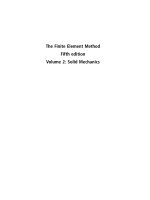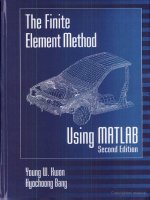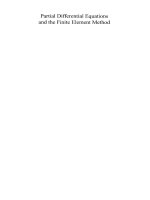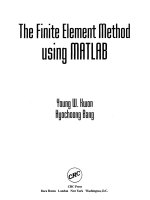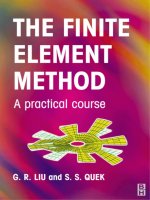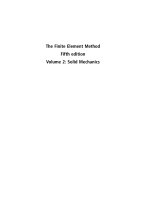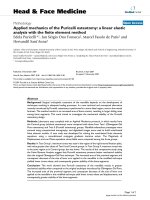The finite element method for mechanics of solids with ANSYS applications
Bạn đang xem bản rút gọn của tài liệu. Xem và tải ngay bản đầy đủ của tài liệu tại đây (16.2 MB, 500 trang )
K12048_cover.fhmx 7/25/11 3:11 PM Page 1
C
M
Y
CM
MY
CY CMY
K
Mechanical Engineering
ELLIS H. DILL
While the finite element method (FEM) has become the standard technique used to solve
static and dynamic problems associated with structures and machines, ANSYS software
has developed into the engineer’s software of choice to model and numerically solve
those problems.
An invaluable tool to help engineers master and optimize analysis, The Finite Element
Method for Mechanics of Solids with ANSYS Applications explains the foundations of FEM
in detail, enabling engineers to use it properly to analyze stress and interpret the output
of a finite element computer program such as ANSYS.
Illustrating presented theory with a wealth of practical examples, this book covers topics
including
• Essential background on solid mechanics (including small- and large-deformation
elasticity, plasticity, viscoelasticity) and mathematics
• Advanced finite element theory and associated fundamentals, with examples
• Use of ANSYS to derive solutions for problems that deal with vibration, wave
propagation, fracture mechanics, plates and shells, and contact
Totally self-contained, this text presents step-by-step instructions on how to use ANSYS
Parametric Design Language (APDL) and the ANSYS Workbench to solve problems
involving static/dynamic structural analysis (both linear and nonlinear) and heat transfer,
among other areas. It will quickly become a welcome addition to any engineering library,
equally useful to students and experienced engineers.
K12048
The Finite Element Method for Mechanics
of Solids with ANSYS Applications
The Finite Element Method for Mechanics
of Solids with ANSYS Applications
The Finite Element
Method for Mechanics
of Solids with
ANSYS Applications
DILL
ELLIS H. DILL
an informa business
6000 Broken Sound Parkway, NW
Suite 300, Boca Raton, FL 33487
711 Third Avenue
New York, NY 10017
2 Park Square, Milton Park
Abingdon, Oxon OX14 4RN, UK
The Finite Element
Method for Mechanics
of Solids with
ANSYS Applications
Advances in Engineering
AÊSeriesÊofÊReferenceÊBooks,ÊMonographs,ÊandÊTextbooks
Series Editor
Haym Benaroya
Department of Mechanical and Aerospace Engineering
Rutgers University
Published Titles:
The Finite Element Method for Mechanics of Solids with ANSYS Applications,
Ellis H. Dill
Dynamics of Tethered Space Systems, A. P. Alpatov, V. V. Beletsky, V. I. Dranovskii,
V. S. Khoroshilov, A. V. Pirozhenko, H. Troger, and A. E. Zakrzhevskii
Lunar Settlements, Haym Benaroya
Handbook of Space Engineering, Archaeology and Heritage, Ann Darrin
and Beth O’Leary
Spatial Variation of Seismic Ground Motions: Modeling and Engineering
Applications, Aspasia Zerva
Fundamentals of Rail Vehicle Dynamics: Guidance and Stability, A. H. Wickens
Advances in Nonlinear Dynamics in China: Theory and Applications, Wenhu Huang
Virtual Testing of Mechanical Systems: Theories and Techniques, Ole Ivar Sivertsen
Nonlinear Random Vibration: Analytical Techniques and Applications, Cho W. S. To
Handbook of Vehicle-Road Interaction, David Cebon
Nonlinear Dynamics of Compliant Offshore Structures, Patrick Bar-Avi
and Haym Benaroya
The Finite Element
Method for Mechanics
of Solids with
ANSYS Applications
ELLIS H. DILL
Boca Raton London New York
CRC Press is an imprint of the
Taylor & Francis Group, an informa business
CRC Press
Taylor & Francis Group
6000 Broken Sound Parkway NW, Suite 300
Boca Raton, FL 33487-2742
© 2011 by Taylor & Francis Group, LLC
CRC Press is an imprint of Taylor & Francis Group, an Informa business
No claim to original U.S. Government works
Version Date: 20140602
International Standard Book Number-13: 978-1-4398-4584-4 (eBook - PDF)
This book contains information obtained from authentic and highly regarded sources. Reasonable efforts
have been made to publish reliable data and information, but the author and publisher cannot assume
responsibility for the validity of all materials or the consequences of their use. The authors and publishers
have attempted to trace the copyright holders of all material reproduced in this publication and apologize to
copyright holders if permission to publish in this form has not been obtained. If any copyright material has
not been acknowledged please write and let us know so we may rectify in any future reprint.
Except as permitted under U.S. Copyright Law, no part of this book may be reprinted, reproduced, transmitted, or utilized in any form by any electronic, mechanical, or other means, now known or hereafter invented,
including photocopying, microfilming, and recording, or in any information storage or retrieval system,
without written permission from the publishers.
For permission to photocopy or use material electronically from this work, please access www.copyright.
com ( or contact the Copyright Clearance Center, Inc. (CCC), 222 Rosewood
Drive, Danvers, MA 01923, 978-750-8400. CCC is a not-for-profit organization that provides licenses and
registration for a variety of users. For organizations that have been granted a photocopy license by the CCC,
a separate system of payment has been arranged.
Trademark Notice: Product or corporate names may be trademarks or registered trademarks, and are used
only for identification and explanation without intent to infringe.
Visit the Taylor & Francis Web site at
and the CRC Press Web site at
Contents
Preface.................................................................................................................... xiii
Author....................................................................................................................... xv
Chapter 1. Finite Element Concepts.......................................................................1
1.1
1.2
Introduction................................................................................1
Direct Stiffness Method.............................................................2
1.2.1 Merging the Element Stiffness Matrices.......................3
1.2.2 Augmenting the Element Stiffness Matrix...................5
1.2.3 Stiffness Matrix Is Banded...........................................5
1.3 The Energy Method....................................................................5
1.4 Truss Example............................................................................7
1.5 Axially Loaded Rod Example.................................................. 13
1.5.1 Augmented Matrices for the Rod................................ 16
1.5.2 Merge of Element Matrices for the Rod...................... 17
1.6 Force Method............................................................................ 18
1.7 Other Structural Components................................................... 21
1.7.1 Space Truss.................................................................. 21
1.7.2 Beams and Frames...................................................... 21
1.7.2.1 General Beam Equations.............................24
1.7.3 Plates and Shells..........................................................26
1.7.4 Two- or Three-Dimensional Solids.............................26
1.8 Problems...................................................................................26
References...........................................................................................28
Bibliography........................................................................................28
Chapter 2. Linear Elasticity.................................................................................. 29
2.1
Basic Equations........................................................................ 29
2.1.1 Geometry of Deformation........................................... 29
2.1.2 Balance of Momentum................................................ 30
2.1.3 Virtual Work............................................................... 30
2.1.4 Constitutive Relations.................................................. 31
2.1.5 Boundary Conditions and Initial Conditions ............. 33
2.1.6 Incompressible Materials............................................ 33
2.1.7 Plane Strain.................................................................34
2.1.8 Plane Stress.................................................................34
2.1.9 Tensile Test.................................................................. 35
2.1.10 Pure Shear................................................................... 36
2.1.11 Pure Bending............................................................... 36
2.1.12 Bending and Shearing................................................. 37
v
vi
Contents
2.1.13 Properties of Solutions................................................ 38
2.1.14 A Plane Stress Example with a Singularity in
Stress...........................................................................40
2.2 Potential Energy....................................................................... 42
2.2.1 Proof of Minimum Potential Energy...........................44
2.3 Matrix Notation........................................................................ 45
2.4 Axially Symmetric Deformations............................................ 48
2.4.1 Cylindrical Coordinates.............................................. 48
2.4.2 Axial Symmetry.......................................................... 49
2.4.3 Plane Stress and Plane Strain...................................... 50
2.5 Problems................................................................................... 50
References........................................................................................... 51
Bibliography........................................................................................ 52
Chapter 3. Finite Element Method for Linear Elasticity...................................... 53
3.1
Finite Element Approximation................................................. 54
3.1.1 Potential Energy.......................................................... 55
3.1.2 Finite Element Equations............................................ 57
3.1.3 Basic Equations in Matrix Notation............................ 58
3.1.4 Basic Equations Using Virtual Work.......................... 59
3.1.5 Underestimate of Displacements.................................60
3.1.6 Nondimensional Equations......................................... 61
3.1.7 Uniaxial Stress............................................................ 63
3.2 General Equations for an Assembly of Elements.....................66
3.2.1 Generalized Variational Principle............................... 68
3.2.2 Potential Energy.......................................................... 69
3.2.3 Hybrid Displacement Functional................................. 69
3.2.4 Hybrid Stress and Complementary Energy................. 70
3.2.5 Mixed Methods of Analysis........................................ 72
3.3 Nearly Incompressible Materials.............................................. 75
3.3.1 Nearly Incompressible Plane Strain............................ 78
Bibliography........................................................................................ 79
Chapter 4. The Triangle and the Tetrahedron....................................................... 81
4.1
4.2
4.3
4.4
4.5
4.6
4.7
4.8
Linear Functions over a Triangular Region.............................. 81
Triangular Element for Plane Stress and Plane Strain.............84
Plane Quadrilateral from Four Triangles................................. 88
4.3.1 Square Element Formed from Four Triangles ...........90
Plane Stress Example: Short Beam.......................................... 93
4.4.1 Extrapolation of the Solution.......................................96
Linear Strain Triangles.............................................................97
Four-Node Tetrahedron............................................................ 98
Ten-Node Tetrahedron..............................................................99
Problems...................................................................................99
vii
Contents
Chapter 5. The Quadrilateral and the Hexahedron............................................. 103
5.1
Four-Node Plane Rectangle.................................................... 103
5.1.1 Stress Calculations.................................................... 109
5.1.2 Plane Stress Example: Pure Bending........................ 110
5.1.3 Plane Strain Example: Bending with Shear.............. 112
5.1.4 Plane Stress Example: Short Beam........................... 112
5.2 Improvements to Four-Node Quadrilateral............................ 115
5.2.1 Wilson–Taylor Quadrilateral..................................... 115
5.2.2 Enhanced Strain Formulation................................... 118
5.2.3 Approximate Volumetric Strains.............................. 122
5.2.4 Reduced Integration on the κ Term........................... 125
5.2.5 Reduced Integration on the λ Term........................... 126
5.2.6 Uniform Reduced Integration................................... 127
5.2.7 Example Using Improved Elements.......................... 130
5.3 Numerical Integration............................................................ 130
5.4 Coordinate Transformations................................................... 133
5.5 Isoparametric Quadrilateral................................................... 134
5.5.1 Wilson–Taylor Element............................................. 138
5.5.2 Three-Node Triangle as a Special Case of
Rectangle................................................................... 138
5.6 Eight-Node Quadrilateral....................................................... 139
5.6.1 Nodal Loads.............................................................. 144
5.6.2 Plane Stress Example: Pure Bending........................ 145
5.6.3 Plane Stress Example: Bending with Shear.............. 145
5.6.4 Plane Stress Example: Short Beam........................... 148
5.6.5 General Quadrilateral Element................................. 148
5.7 Eight-Node Block................................................................... 149
5.8 Twenty-Node Solid................................................................. 152
5.9 Singularity Element................................................................ 152
5.10 Mixed U–P Elements............................................................. 154
5.10.1 Plane Strain............................................................... 154
5.10.2 Alternative Formulation for Plane Strain.................. 158
5.10.3 3D Elements.............................................................. 160
5.11 Problems................................................................................. 163
References......................................................................................... 168
Bibliography...................................................................................... 169
Chapter 6. Errors and Convergence of Finite Element Solution......................... 171
6.1
6.2
General Remarks.................................................................... 171
Element Shape Limits............................................................. 173
6.2.1 Aspect Ratio.............................................................. 173
6.2.2 Parallel Deviation for a Quadrilateral....................... 174
6.2.3 Large Corner Angle.................................................. 175
6.2.4 Jacobian Ratio........................................................... 175
viii
Contents
6.3
Patch Test................................................................................ 176
6.3.1 Wilson–Taylor Quadrilateral..................................... 178
References......................................................................................... 180
Chapter 7. Heat Conduction in Elastic Solids..................................................... 181
7.1
7.2
7.3
7.4
Differential Equations and Virtual Work............................... 181
Example Problem: One-Dimensional Transient Heat Flux.... 185
Example: Hollow Cylinder..................................................... 187
Problems................................................................................. 188
Chapter 8. Finite Element Method for Plasticity................................................ 191
8.1
Theory of Plasticity................................................................ 191
8.1.1 Tensile Test................................................................ 194
8.1.2 Plane Stress............................................................... 195
8.1.3 Summary of Plasticity............................................... 196
8.2 Finite Element Formulation for Plasticity.............................. 197
8.2.1 Fundamental Solution............................................... 198
8.2.2 Iteration to Improve the Solution............................... 199
8.3 Example: Short Beam............................................................. 201
8.4 Problems.................................................................................203
Bibliography......................................................................................204
Chapter 9. Viscoelasticity...................................................................................205
9.1
Theory of Linear Viscoelasticity............................................205
9.1.1 Recurrence Formula for History............................... 210
9.1.2 Viscoelastic Example................................................ 211
9.2 Finite Element Formulation for Viscoelasticity..................... 215
9.2.1 Basic Step-by-Step Solution Method......................... 216
9.2.2 Step-by-Step Calculation with Load Correction....... 217
9.2.3 Plane Strain Example................................................ 218
9.3 Problems................................................................................. 219
Bibliography...................................................................................... 220
Chapter 10. Dynamic Analyses............................................................................ 221
10.1 Dynamical Equations............................................................. 221
10.1.1 Lumped Mass............................................................ 221
10.1.2 Consistent Mass . ...................................................... 222
10.2 Natural Frequencies . .............................................................224
10.2.1 Lumped Mass............................................................224
10.2.2 Consistent Mass . ...................................................... 225
10.3 Mode Superposition Solution................................................. 225
10.4 Example: Axially Loaded Rod............................................... 227
Contents
ix
10.4.1 Exact Solution for Axially Loaded Rod.................... 227
10.4.2 Finite Element Model................................................ 229
10.4.2.1 One-Element Model................................... 229
10.4.2.2 Two-Element Model.................................. 230
10.4.3 Mode Superposition for Continuum Model of
the Rod...................................................................... 232
10.5 Example: Short Beam............................................................. 236
10.6 Dynamic Analysis with Damping ......................................... 237
10.6.1 Viscoelastic Damping............................................... 238
10.6.2 Viscous Body Force ................................................. 239
10.6.3 Analysis of Damped Motion by Mode
Superposition.............................................................240
10.7 Numerical Solution of Differential Equations........................ 241
10.7.1 Constant Average Acceleration................................. 241
10.7.2 General Newmark Method........................................ 243
10.7.3 General Methods.......................................................244
10.7.3.1 Implicit Methods in General . ...................244
10.7.3.2 Explicit Methods in General . ...................244
10.7.4 Stability Analysis of Newmark’s Method................. 245
10.7.5 Convergence, Stability, and Error.............................246
10.7.6 Example: Numerical Integration for Axially
Loaded Rod............................................................... 247
10.8 Example: Analysis of Short Beam.......................................... 249
10.9 Problems................................................................................. 251
Bibliography...................................................................................... 253
Chapter 11. Linear Elastic Fracture Mechanics................................................... 255
11.1 Fracture Criterion................................................................... 255
11.1.1 Analysis of Sheet....................................................... 257
11.1.2 Fracture Modes......................................................... 258
11.1.2.1 Mode I........................................................ 258
11.1.2.2 Mode II...................................................... 259
11.1.2.3 Mode III . .................................................. 259
11.2 Determination of K by Finite Element Analysis....................260
11.2.1 Crack Opening Displacement Method......................260
11.3 J-Integral for Plane Regions................................................... 263
11.4 Problems................................................................................. 267
References......................................................................................... 268
Bibliography...................................................................................... 268
Chapter 12. Plates and Shells................................................................................ 269
12.1 Geometry of Deformation...................................................... 269
12.2 Equations of Equilibrium....................................................... 270
12.3 Constitutive Relations for an Elastic Material........................ 271
x
Contents
12.4 Virtual Work........................................................................... 273
12.5 Finite Element Relations for Bending.................................... 276
12.6 Classical Plate Theory............................................................280
12.7 Plate Bending Example.......................................................... 282
12.8 Problems................................................................................. 287
References......................................................................................... 288
Bibliography...................................................................................... 289
Chapter 13. Large Deformations.......................................................................... 291
13.1 Theory of Large Deformations............................................... 291
13.1.1 Virtual Work............................................................. 292
13.1.2 Elastic Materials........................................................ 293
13.1.3 Mooney–Rivlin Model of an Incompressible
Material..................................................................... 297
13.1.4 Generalized Mooney–Rivlin Model.......................... 298
13.1.5 Polynomial Formula.................................................. 301
13.1.6 Ogden’s Function....................................................... 303
13.1.7 Blatz–Ko Model........................................................304
13.1.8 Logarithmic Strain Measure.....................................306
13.1.9 Yeoh Model...............................................................307
13.1.10Fitting Constitutive Relations to
Experimental Data....................................................308
13.1.10.1. Volumetric Data......................................308
13.1.10.2. Tensile Test..............................................308
13.1.10.3. Biaxial Test..............................................309
13.2 Finite Elements for Large Displacements..............................309
13.2.1 Lagrangian Formulation............................................ 311
13.2.2 Basic Step-by-Step Analysis..................................... 312
13.2.3 Iteration Procedure.................................................... 312
13.2.4 Updated Reference Configuration............................. 313
13.2.5 Example I.................................................................. 315
13.2.6 Example II................................................................. 315
13.3 Structure of Tangent Modulus................................................ 317
13.4 Stability and Buckling............................................................ 318
13.4.1 Beam–Column.......................................................... 319
13.5 Snap-Through Buckling......................................................... 319
13.5.1 Shallow Arch............................................................. 323
13.6 Problems................................................................................. 324
References......................................................................................... 326
Bibliography...................................................................................... 326
Chapter 14. Constraints and Contact.................................................................... 327
14.1 Application of Constraints...................................................... 327
14.1.1 Lagrange Multipliers................................................. 327
Contents
xi
14.1.2 Perturbed Lagrangian Method.................................. 329
14.1.3 Penalty Functions...................................................... 331
14.1.4 Augmented Lagrangian Method............................... 332
14.2 Contact Problems.................................................................... 333
14.2.1 Example: A Truss Contacts a Rigid Foundation....... 333
14.2.1.1 Load Fy > 0 Is Applied with Fx = 0............ 335
14.2.1.2 Loads Are Ramped Up Together:
Fx = 27α, Fy = 12.8α................................... 336
14.2.2 Lagrange Multiplier, No Friction Force.................... 337
14.2.2.1 Stick Condition.......................................... 338
14.2.2.2 Slip Condition............................................ 338
14.2.3 Lagrange Multiplier, with Friction............................ 338
14.2.3.1 Stick Condition.......................................... 339
14.2.3.2 Slip Condition............................................ 339
14.2.4 Penalty Method ........................................................340
14.2.4.1 Stick Condition.......................................... 341
14.2.4.2 Slip Condition............................................ 341
14.3 Finite Element Analysis......................................................... 341
14.3.1 Example: Contact of a Cylinder with a Rigid
Plane.......................................................................... 342
14.3.2 Hertz Contact Problem.............................................. 343
14.4 Dynamic Impact.....................................................................346
14.5 Problems................................................................................. 347
References.........................................................................................348
Bibliography......................................................................................348
Chapter 15. ANSYS APDL Examples.................................................................. 349
15.1 ANSYS Instructions............................................................... 349
15.1.1 ANSYS File Names................................................... 351
15.1.2 Graphic Window Controls........................................ 352
15.1.2.1 Graphics Window Logo............................. 352
15.1.2.2 Display of Model....................................... 352
15.1.2.3 Display of Deformed and Undeformed
Shape White on White............................... 352
15.1.2.4 Adjusting Graph Colors............................. 352
15.1.2.5 Printing from Windows Version of
ANSYS...................................................... 353
15.1.2.6 Some Useful Notes.................................... 353
15.2 ANSYS Elements SURF153, SURF154................................. 353
15.3 Truss Example........................................................................ 354
15.4 Beam Bending........................................................................ 357
15.5 Beam with a Distributed Load...............................................360
15.6 One Triangle........................................................................... 361
15.7 Plane Stress Example Using Triangles...................................364
15.8 Cantilever Beam Modeled as Plane Stress............................. 366
xii
Contents
15.9 Plane Stress: Pure Bending.................................................... 369
15.10 Plane Strain Bending Example............................................... 371
15.11 Plane Stress Example: Short Beam........................................ 376
15.12 Sheet with a Hole.................................................................... 379
15.12.1Solution Procedure.................................................... 379
15.13 Plasticity Example.................................................................. 381
15.14 Viscoelasticity Creep Test...................................................... 387
15.15 Viscoelasticity Example......................................................... 391
15.16 Mode Shapes and Frequencies of a Rod................................. 394
15.17 Mode Shapes and Frequencies of a Short Beam.................... 397
15.18 Transient Analysis of Short Beam.......................................... 398
15.19 Stress Intensity Factor by Crack Opening Displacement.......400
15.20 Stress Intensity Factor by J-Integral.......................................402
15.21 Stretching of a Nonlinear Elastic Sheet.................................405
15.22 Nonlinear Elasticity: Tensile Test...........................................408
15.23 Column Buckling................................................................... 412
15.24 Column Post-Buckling .......................................................... 415
15.25 Snap-Through......................................................................... 417
15.26 Plate Bending Example.......................................................... 420
15.27 Clamped Plate........................................................................ 423
15.28 Gravity Load on a Cylindrical Shell...................................... 425
15.29 Plate Buckling........................................................................ 429
15.30 Heated Rectangular Rod........................................................ 432
15.31 Heated Cylindrical Rod.......................................................... 434
15.32 Heated Disk............................................................................ 438
15.33 Truss Contacting a Rigid Foundation..................................... 442
15.34 Compression of a Rubber Cylinder between Rigid Plates.....446
15.35 Hertz Contact Problem........................................................... 451
15.36 Elastic Rod Impacting a Rigid Wall....................................... 456
15.37 Curve Fit for Nonlinear Elasticity Using Blatz–Ko Model....460
15.38 Curve Fit for Nonlinear Elasticity Using Polynomial Model....464
Bibliography......................................................................................469
Chapter 16. ANSYS Workbench........................................................................... 471
16.1 Two- and Three-Dimensional Geometry............................... 471
16.2 Stress Analysis........................................................................ 472
16.3 Short Beam Example.............................................................. 473
16.3.1 Short Beam Geometry............................................... 473
16.3.2 Short Beam, Static Loading...................................... 474
16.3.3 Short Beam, Transient Analysis................................ 476
16.4 Filleted Bar Example.............................................................. 477
16.5 Sheet with a Hole....................................................................480
Bibliography...................................................................................... 482
Index....................................................................................................................... 483
Preface
The purpose of this book is to explain application of the finite element method to
problems in the mechanics of solids. It is intended for practicing engineers who
use the finite element method for stress analysis and for graduate students in engineering who want to understand the finite element method for their research. It is
also designed as a textbook for a graduate course in engineering. Application of the
finite element method is illustrated by using the ANSYS computer program. Stepby-step instructions for the use of ANSYS Parametric Design Language (APDL) and
ANSYS Workbench in more than 40 examples are included.
The required background material in the mechanics of solids is provided so that
the work is self-contained for the knowledgeable reader. A more complete treatment of solid mechanics is provided in the book Continuum Mechanics: Elasticity,
Plasticity, Viscoelasticity by Ellis H. Dill (CRC Press, 2007). References to that
book are noted in this book on an applicable page by a footnote (Dill: specific referral
detail).
This book is not intended as a detailed reference book on the use of the ANSYS
system. However, Chapters 15 and 16 contain detailed steps for the application of
ANSYS in numerous examples, which will enable the user to become fairly proficient in the use of this software. The new user should begin with one of the tutorials
provided by ANSYS or with one of the elementary books listed in the bibliography in Chapters 15 and 16. This book was written using Version 12.1. However, the
examples in Chapters 15 and 16 can be executed using either Version 12 or Version
13. I do not pretend to present a detailed analysis of finite element as implemented
by ANSYS. I do not have access to their computer coding. I believe that the elements
they are using are essentially the same as those presented here, although they may
differ in some details.
I have attempted to cover only the essentials of the subject and to provide the tools
necessary for comprehension of the technical literature and the commercial finite
element programs. I apologize in advance to all of the originators of this material
who are not referenced. I have long ago forgotten where I learned the theory.
BoCheng Jin helped with the preparation of the manuscript and provided many
corrections to it. Of course, any remaining errors are mine alone.
ANSYS, ANSYS Workbench, and ANSYS APDL are trademarks of ANSYS,
Inc. The software was used for examples, and the results cited, by special permission
from ANSYS, Inc.
xiii
Author
Ellis H. Dill obtained his BS, MS, and PhD from the University of California
(Berkeley) in civil engineering. He taught aeronautical engineering at the University
of Washington (Seattle) from 1956 to 1977. He was dean of engineering at Rutgers,
the State University of New Jersey, from 1977 to 1998. Dr. Dill is currently a university professor at Rutgers, teaching mechanical and aerospace engineering. His principal research areas include aircraft structures, analysis of plates and shells, solid
mechanics, and the finite element method of stress analysis. He can be reached by
email at
xv
1 Finite Element Concepts
1.1 Introduction
The finite element method (FEM) has developed along two paths. From the mathematical point of view, it is a method of constructing a function that makes the
potential energy a minimum. From the engineering point of view, it is a method
of assembling structural elements, which can be separately analyzed, into a global
equation of equilibrium for the structure. The mathematical point of view makes
the FEM a special form of the Rayleigh–Ritz method, which has a long history. The
modern FEM may be said to have begun with Courant in 1943.1 His paper had little
impact because the method was not practical until the development of digital computers in the 1950s. This approach has now been extensively explored by mathematicians and placed on a sound mathematical basis. Precise studies of error analysis and
convergence proofs are available.2–5 However, the study of the mathematical foundations, involving Sobolev spaces, is beyond the scope of this book.
The emphasis in this book is on the direct stiffness method in which the unknowns
are the displacements of particular points, and to a lesser degree on the mixed (U-P)
method, in which the mean stress is a primary variable. However, Chapter 3 contains the fundamental variational theorems underlying the general mixed and hybrid
methods that seemed to show great promise but have not achieved prominence in
practical engineering analysis. The most significant omission is the new meshless
method of analysis that has been recently developed.6
The analysis of structures by dividing them into elements, such as beams, stringers, shear panels, and so forth, which can be separately analyzed, has been developed over the past hundred years into a standard method of engineering analysis.
Organization of the calculations using matrix algebra was widely developed, from
about 1950 onward, as computers became available that made such computational
methods practical.7 A landmark paper on the application of the direct stiffness formulation to continuum problems was published by Turner, Clough, Martin, and Topp
in 1956.8 The method was later named “finite element” method by Clough,9 in contrast to the finite difference method that was widely used for solution of continuum
problems at that time.
From the viewpoint of the structural engineer, the analysis of a structure is accomplished by writing equations for the assembly of structural elements that describe
(1)Compatibility or continuity of the deformations
(2)Equilibrium of the contact forces at joints
(3)Force–deformation relations for the elements
In the direct stiffness method, from which the FEM evolved, continuity of the displacements (and rotations) is achieved by expressing all of the elements and joint
1
2
The Finite Element Method for Mechanics of Solids with ANSYS Applications
displacements in a single global coordinate system and then equating the displacements where elements are joined. The equilibrium of forces acting on the joints
is then easily expressed by using the same global coordinate system for the contact forces from the joined structural elements. The force–deformation relation is a
relation expressing the forces acting on an element as a linear function of the joint
displacements. The coefficient matrix is called the element stiffness matrix for the
element. Elimination of the element forces from the equilibrium equations leads to a
single linear algebraic equation for the external forces in terms of the joint displacements. The coefficient matrix is called the global stiffness matrix.
In this book, the emphasis will be on FEM as a systematic method for constructing a function that makes the potential energy a minimum. However, the concepts
that have arisen from matrix formulations of structural analysis will also be used.
For example, the direct addition, or merge, of element stiffness matrices will be an
important concept.
I will first summarize the direct stiffness method of structural analysis in more
detail from the viewpoint of the structural engineer.
1.2 Direct Stiffness Method
A structure can be modeled as an assembly of elements that are joined at discrete
points called nodes. For example, a truss consists of axial force elements joined
at their ends. A frame consists of beam elements. An airplane consists of frames,
stringers, spars, and shear panels. A mechanical component can be modeled as an
assembly of solid elements joined at the corners.
We can introduce a global rectangular Cartesian coordinate system for components of displacement of the joints and the external forces applied to the joint. The
term “displacements” includes rotations, which are considered to be “generalized displacements.” All elements connected to a common joint share the displacements of
that joint. Let us denote the components of joint displacement in the global Cartesian
coordinate system by D1, D2, D3, etc., and the corresponding components of external
force by F1, F2, F3, etc. The forces may be either reactions or given external loads.
The subscripts can be assigned in any order, but each component is given a distinct
label and the indices range consecutively from 1 to N, with N being the total number
of components of joint displacements for the structure. We call each displacement
component Di a degree of freedom (DOF).
For each element, we must establish a relation between the internal forces exerted
by the joints on the element and the displacements of the joints to which the element is attached. This is accomplished by a stress analysis of the element that is
done before we began to analyze the articulated structure. For example, for a truss
member in the elastic range, the axial force is proportional to the elongation. For a
beam element in the elastic range, the joint forces consist of forces and moments that
are linearly related to the displacements and rotations of the ends of the beam. The
moments are regarded as “generalized forces.” For an element m, which behaves
elastically and has only small displacements, the relation between joint displacements and element forces (components in the global Cartesian system) is expressed
by a linear equation:
3
Finite Element Concepts
fi m =
∑k
D j , i, j ∈ Im .
m
ij
j
(1.1)
This relation involves only a subset of joint displacements: i is in the index set Im of
displacements for the member m. The summation implied by the repeated index j is
over the set Im. The forces fi m are the components of force exerted by the joint on
the element, acting in the same direction as the corresponding joint displacement Di,
and they are numbered by the same index number i. The matrix km with elements
kijm is therefore a square matrix called the stiffness matrix of element m. It is always
a symmetric matrix:
kijm = k mji .
(1.2)
The element stiffness relation 1.1 can be written as a matrix equation:
fm = kmDm, no sum on m.
(1.3)
However, the indices (ij) denote the related displacement component and do not follow the standard row–column matrix notation. The element stiffness matrix is a
symmetric square matrix with the number of columns and rows equal to the number
of displacement components of the joints attached to member m.
1.2.1 Merging the Element Stiffness Matrices
We must now set forth the requirement that the forces applied to the joint by the elements are in equilibrium with the external forces applied to the joint. Resolving the
external forces into the same components as we used for the joint displacements and
member forces, we have, for joint n, the relation
Fi =
∑f
i
m
, i ∈ Dn .
m∈M i
(1.4)
The range of m is over the index set Mi of members that share the DOF Di. The range
of i is over the index set Dn of displacement components for the joint n. Substituting
the element stiffness relations 1.1 into the joint equilibrium Equations 1.4, we obtain
the global relation between external force and joint displacement. This operation is
to be done for all joints to obtain one equation for each DOF, i = 1 to N:
Fi =
kijm D j
m∈M i j ∈Im
∑∑
=
kikm Dk .
k ∈Ci m∈M i
∑∑
(1.5)
4
The Finite Element Method for Mechanics of Solids with ANSYS Applications
The summation on k in the second term is over the set Ci of those DOFs that are connected to the ith DOF by some member, that is, the connectivity of the structure. By
definition, no two joints share the same Fi or Di, and the total number of such force
and displacement components is N, that is, i = 1 to N.
The summation on k in the last term can be extended to the full range of
displacements,
N
Fi =
∑K D ,
ik
k =1
(1.6)
k
by defining Kik = 0 for those k such that Di and Dk are not connected by any
member:
kikm for k ∈ Ci ,
K ik = m∈M i
0 for k ∉ C .
i
∑
(1.7)
F = KD
(1.8)
Then, in matrix notation,
This summation of the element stiffness matrices is called merging of the matrices
to form the global stiffness matrix. In the global N × N stiffness matrix K with terms
Kik, the index i becomes the row number and the index k becomes the column number of the term.
In Equation 1.7, we are merely adding together all of the terms with common
indices from each of the element matrices. We can start by setting all of the terms
in the global stiffness matrix K to zero. We then take any one element and add
all of the terms from the element stiffness matrix directly into the global stiffness
matrix at the appropriate location. Then we go to the next element and repeat
the addition of terms from the element stiffness matrix into the global stiffness
matrix. This is the process that gave rise to the terminology “merging the stiffness matrices.” It is an efficient numerical method for forming the global stiffness
matrix. Henceforth, when we indicate a summation of element stiffness matrices,
the summation will be understood to mean that element stiffness matrices are
merged.
The external forces F consist of the externally applied loads and reactions and
the inertial forces. If we approximate the inertial forces by lumping the mass at the
joints, the inertial force is (–miDi), no sum on i, for each DOF. The general form of
Equation 1.8 including inertial forces is
= KD
F − MD
where M is a diagonal matrix with the lumped masses mi on the diagonal.
(1.9)
5
Finite Element Concepts
1.2.2 Augmenting the Element Stiffness Matrix
It is sometimes helpful to visualize geometrically the process of forming the global
stiffness matrix K from the element stiffness matrices. One can imagine that each
element stiffness matrix is increased in size to match the global stiffness by inserting
zero terms for all terms, other than those terms corresponding to the indices i and j
occurring in the element array kijm, to obtain an N × N element matrix kˆijm. Equation
1.7 then expresses the ordinary matrix addition:
K=
∑ kˆ ,
m
m
(1.10)
where the summation is over the totality of elements and kˆ m is the element matrix
augmented by zeros. This has several advantages conceptually. One may think of
each element stiffness matrix as written on a sheet of paper with the terms kijm entered
into the row and column of the global array as dictated by indices i and j. The sheets
of paper are laid on top of one another and the elements are added that lie in the
same position. However, this is not a good plan for computations because it involves
manipulating a lot of zeros.
1.2.3 Stiffness Matrix Is Banded
The geometrical concept of merging the element stiffness matrices is also helpful in
understanding the banded nature of the global stiffness matrix. If we are forming the
row of K corresponding to say F1, then the only elements that will contribute terms
to this row are those attached to the joint having the DOF D1, and the only terms that
those elements can contribute to K will be those for the columns corresponding to
the displacements of the other DOFs associated with those elements. Consequently,
only those terms in that row that are contributed by the elements sharing the DOF D1
can be nonzero. Beyond a certain column number, all of the remaining terms of the
row F1 are zero. Thus, the nonzero terms are confined to a band emanating from the
diagonal elements of K. By numbering the joint displacements judiciously, we can
minimize the width of this band and confine the nonzero terms to a relatively small
band around the diagonal of K.
1.3 The Energy Method
The calculations can also be described in terms of the potential energy. The strain
energy of each element is
Um =
∑∑ k
i ∈Im j ∈Im
m
ij
Di D j =
1 m T m m
(D ) k D ,
2
(1.11)
where Dm denotes the column matrix of the DOFs for the element m. We will see
later how this formula for the strain energy is derived from the field equations of
6
The Finite Element Method for Mechanics of Solids with ANSYS Applications
linear elasticity. The strain energy of the collection of elements is the sum of the
stain energy of each one:
U=
∑U
m
m
=
kijm Di D j
j ∈Im
∑ ∑∑
m
=
i∈I
m
N
N
i =1
j =1
∑∑ K D D
ij
i
(1.12)
j
where K is the merge of the element matrices. In matrix notation,
U=
1 T
D KD
2
(1.13)
where the global stiffness matrix K is the result of merging the element stiffness
matrices km as described above.
In the case of given loads F applied to the joints, the potential of the external
loads is the negative of the force times the displacement. The potential energy for the
system is therefore
P = U − FTD =
1 T
D KD − F T D .
2
(1.14)
The condition for a minimum of the potential energy is
∂P
=0
∂Di
(1.15)
where i ranges over all of the (unknown) DOFs. Applying this condition to the total
potential 1.14 gives the global Equations 1.8 of equilibrium:
KD = F.
(1.16)
The energy method is one that we will exploit for the general formulation.* It offers
several advantages. First, the calculations are automatic once the element stiffness
matrices have been determined. Second, approximate solutions are readily formulated by simply deriving an approximate potential energy. Third, the mathematical
studies of error and convergence often make explicit use of the minimum of the
potential energy in equilibrium problems.
* Actually, we will use the first derivative which is called the virtual work formula.
7
Finite Element Concepts
The energy method can be extended to explicitly include the inertial forces by
introducing the kinetic energy. If the mass is lumped at a node point (joint), the
kinetic energy associated with Dj is
Tj =
1
m j D j D j , (no sum).
2
(1.17)
The total kinetic energy of the system is the sum over the number of DOFs:
∑T .
(1.18)
1 T
D MD,
2
(1.19)
T=
j
j
Combining 1.17 and 1.18, we find
T=
where the global mass matrix is the result just a diagonal matrix consisting of the
individual lumped masses. The equations of motion can be derived from Lagrange’s
equations
d ∂T
∂T
∂P
.
−
=−
dt ∂D j ∂D j
∂D j
(1.20)
this leads to the general equations of motion for the discrete system:
+ KD = F
MD
(1.21)
This is a set of linear ordinary differential equations that can be solved by standard
methods. However, because of the banded nature of M and K, special techniques can
be used to reduce the computational effort.
1.4 Truss Example
A truss is a collection of axial force members that are joined at the ends in
such a way that there is no restraint on the relative rotation of the members at
the joint. Each member can be considered an element. The joints are the nodes.
The components of displacement of the joints are the degrees of freedom of the
structure.
Let us consider the truss shown in Figure 1.1, which has three elements and four
nodes numbered as shown. The DOFs are labeled as shown in Figure 1.2. In this
case, the total number of DOFs is N = 8. The forces exerted on the elements by the
nodes are shown in Figure 1.3, with positive directions as shown.
8
The Finite Element Method for Mechanics of Solids with ANSYS Applications
3L
2
4L
4
3
2
3
1
4L
y
1
x
FIGURE 1.1 Truss example.
D4
2
D6
D3
D8
D5
3
2
3
1
y
D1
1
x
D7
4
D2
FIGURE 1.2 Degrees of freedom for truss.
f33
2
y
f52
3
4
2
3
x
f81
f62
f43
1
f23
f13
1
f71
1
1
f12
f22
f11
f21
FIGURE 1.3 Element forces.
The force–displacement relations for member 1 are
fi1 = ki11D1 + ki12 D2 + ki17 D7 + ki18 D8 ,
i ∈ I1 , I1 = (1, 2, 7, 8),
(1.22)
or
fi1 =
∑k D .
1
ij
j ∈I1
(1.23)
j
